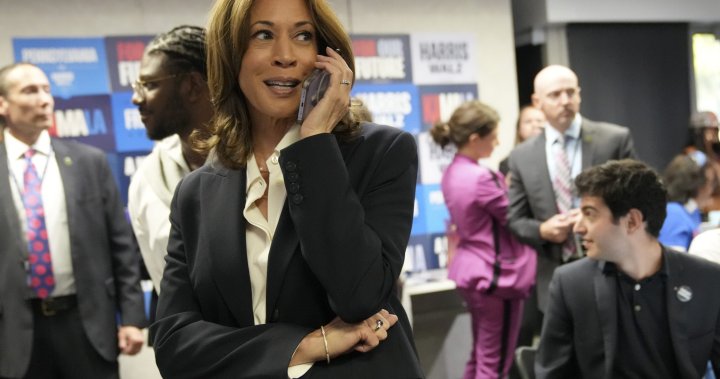Amid the growing trend of Canadians seeking health-care guidance online, YouTube is poised to confront the issue of misinformation head-on.
Starting Thursday, the video platform will begin verifying health-care creators’ credentials, ensuring that only licensed and trusted doctors, nurses and mental health professionals deliver authoritative content on YouTube Health.
“We have billions of views of health content in Canada. So it is of that scale that we know Canadians are coming to our platform for health information,” explained Dr. Garth Graham, a cardiologist and the global head of YouTube Health. “That’s why we’re doing our best to get them high-quality health information.”
YouTube Health first launched in Canada in 2022 to make it easier for people to find trusted health information online. The platform has also already paired with health organizations such as the World Health Organization (WHO), the Centre for Addiction and Mental Health (CAMH) and Toronto’s Hospital for Sick Children.
The health channel is now expanding to include licensed doctors, nurses and mental health professionals.

“On May 16 is when we bring this to Canada and when Canadian health creators can apply to get this label as well as be a part of these health features are being, visible and being shown in our health shelter label that note that they are licensed doctors, nurses, or mental health professionals,” Graham told Global News.
The platform already offers this feature in places like the United States, Germany, Japan and Brazil.
Timothy Caulfield, a Canada Research Chair in health law and policy at the University of Alberta, said YouTube’s new feature is a “good idea,” as misinformation, especially in the health field, is rampant online.
“Health misinformation, it’s killing people. So this really does matter,” Caulfield said. “Increasingly people, including here in Canada, are getting their information from platforms like YouTube, especially in the health space. And we also know that these platforms are a source of a great deal of misinformation.”
YouTube is a widely sought-after platform for health-related content, a fact that Dr. Siobhan Deshauer, an internal medicine physician in Toronto, is keenly aware of.
The latest health and medical news
emailed to you every Sunday.
Deshauer has a YouTube channel that delves into medical mysteries, offers health advice and conducts interviews with patients. Started seven years ago, her channel now has more than one million subscribers and her videos have more than 40 million views, a number higher than she ever expected. But to her, these numbers provide a clear indication of the content Canadians are seeking.
“I created the YouTube channel at the beginning of my residency, and it was primarily to help educate and try to make information a little bit more approachable. Because I noticed that health care, so much of it happens behind closed doors, and I find that that can be a little bit intimidating for people to get involved with,” she told Global News.
“I wanted to try to bring people behind the scenes and give them some more information that was more approachable and more transparent.”
Dr. Siobhan Deshauer started the YouTube channel as a way to help teach Canadians about their own health.
Dr. Siobhan Deshauer
Deshauer has an accredited channel on YouTube Health, as she was included as part of the testing to get the product live.
The goal of YouTube Health is to provide quality health information, Graham stressed.
“In Canada, people come to YouTube as a source for health information. When people wake up in the night and they’re worried about a symptom or they just have health questions, often they’re not able to get in contact with their doctor. So they’re looking up information online and then Google and then YouTube,” he explained.
“And we want to make sure that when they’re searching for health information on YouTube, the kinds of sources that they encounter initially are sources that are going to be delivering evidence-based, quality health information so that can help in their overall health journey.”
A professional who wants to be accredited on the channel must undergo a rigorous verification process to ensure they meet the platform’s standards for accuracy and expertise, Graham said. There is a set of principles developed by the National Academy of Medicine (NAM), the Council of Medical Speciality Societies (CMSS) and the World Health Organization (WHO) to determine their credibility.

Health professionals seeking accreditation on YouTube Health must go through the application process, such as ensuring they are licensed, use evidence-based practice and do not have conflicts of interest, Graham explained. Once verified, viewers will notice a distinct label at the bottom of the screen, signifying the information’s source as a licensed health professional.
Accredited professionals also enjoy enhanced visibility on the platform, he said, with YouTube’s algorithm favouring their content, ensuring it appears prominently in search results.
Doctors, nurses and other medical professionals can apply for an accredited account here.
Can this initiative combat misinformation?
There is no doubt that platforms like YouTube recognize that they can help spread misinformation, Caulfield said.
“All the platforms, not just YouTube, all the social media platforms, they’re kind of at the epicentre of this misinformation crisis,” he said. “I think you’re starting to see some of these platforms try to position themselves as if they are really trying to address this global issue in a responsible way.”
In the fight against misinformation, he sees accredited accounts on YouTube Health as a positive step forward. However, he also cautioned that there may be challenges to consider.
He says those who spread misinformation are “nimble” and may be capable of circumventing the verification processes implemented by YouTube. This, he added, poses a significant challenge for the social media giant.

“The other thing that we know is the verification or labelling of a process is not foolproof. If everything isn’t labelled, does that mean that everything that doesn’t have a label is bad?” he asked.
“So, I think we need to see the impact of this labelling process on how people perceive all the health information content. It’s complex. There are definitely pitfalls associated with this, but given how problematic health misinformation is, I think we’ve got to start trying stuff.”
Graham emphasized that the company has the technology in place to detect and monitor harmful misinformation on the platform.
“When it is harmful or dangerous (it will) remove that content. And so that’s always in play in the background as we’re moving forward to have features like this. We always have those guardrails in place in terms of safety,” he said.





